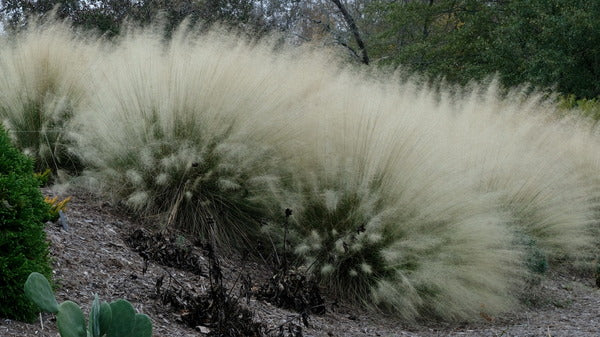Vast swaths of pink clouds have become customary in the Southeastern landscapes of the United States, they’ve even been utilized by some states in their interstate plantings. Pink muhly grass has gained wide appreciation for its dramatic late autumn show and relative durability. Pink muhly is universally marketed under the scientific name Muhlenbergia capillaris. Unfortunately, that isn’t the identity of most plants in cultivation. To understand how this misapplication occurred it is important to revisit the confusing taxonomic history of the grasses in the genus Muhlenbergia.
The History of Pink Muhly Grass
Muhlenbergia, as a genus, was constructed by Johann Christian Daniel von Schreber (1739-1810) in honor of Pennsylvanian plantsman Gotthilf Heinrich Ernst Muhlenberg (1753-1815). Muhlenbergia capillaris was initially described as Stipa capillaris by Lamarck and transferred to the genus Muhlenbergia by Trinius. The correct format for the scientific name is thus: Muhlenbergia capillaris (Lamarck) Trinius, where Lamarck’s original description of the plant is maintained in parenthesis (called a parenthetical authority). Whew! If that isn’t confusing enough for you the story continues to get more complex.
Muhlenbergia sericea (capillaris of Horticulture)
Moses Ashley Curtis (1808-1872) was born in Massachusetts, educated at Williams College, and spent most of his adult life in North Carolina. He worked and lived as a tutor in Wilmington and then as a rector for the Episcopal Church in Raleigh and Hillsborough, North Carolina. Curtis described a new species that grows along the margins of salt marsh and behind the dunes found from North Carolina to Florida as Muhlenbergia filipes M.A. Curtis, in 1843. Curtis’ plant is the well-known “sweetgrass” that is utilized by Gullah craftspeople to construct the famous sweetgrass baskets that so many tourists covet when visiting Charleston, South Carolina. It was also utilized for baskets by Native American groups such as the Seminole. Unbeknownst to Curtis, André Michaux had described the same plant as Stipa sericea in his posthumously published flora in 1803. Because Michaux’s name predates the use of filipes, it must be maintained even when transferred to the genus Muhlenbergia. Therefore, the sweetgrass plant is known today as Muhlenbergia sericea (Michaux) P.M. Patterson.
Muhlenbergia Capillaris or Muhlenbergia Sericea?
Now to drop the bomb… pink muhly grass, in the horticultural trade, is sweetgrass (Muhlenbergia sericea), NOT Muhlenbergia capillaris. The difference is evident every autumn when the clouds of wispy florets with their elongate pink awns are produced. Grass florets (flowers) are generally composed of two small bract-like structures called a palea and a lemma. The lemma (the outermost of the two) often has an awn attached to the tip (an elongate hair-like structure). This awn, combined with the pink pedicels, gives most of the color and beauty to our pink muhly. The awn in Muhlenbergia capillaris is very short (3-13 mm long) while the awns on Muhlenbergia sericea is much longer (12- 35 mm long). Muhlenbergia capillaris is a small plant with fewer flowers per stem and is not nearly as showy as sweetgrass (M. sericea). Even the popular cultivar introduced by Superior Trees in Florida, ‘White Cloud’ is representative of the long-awned, showy sweetgrass.
Muhlenbergia sericea 'White Cloud'
So how did we get the name wrong in horticulture? It all goes back to the differences in opinions of botanists and the lack of precision in horticulture. Some botanists, like Richard Wunderlin, who published the Guide to the Vascular Plants of Central Florida in 1986 and the Guide to the Vascular Plants of Florida in 1998 recognizes Muhlenbergia capillaris with three varieties: var. capillaris, var. filipes and var. trichopodes. So, calling Pink Muhly or the cultivar ‘White Cloud’ by the name Muhlenbergia capillaris was not incorrect according to Wunderlin’s point of view, but it should have included the variety, which would have been var. filipes. The confusion we see today is because most cultivated plants being offered for sale today originated from Florida collections, produced by Florida producers.
Today, sweetgrass is accepted as a valid species known as Muhlenbergia sericea and we, in the horticultural community, should strive to utilize the correct name for this species which has a much more southerly, coastal range, less cold hardiness, and therefore requires different garden conditions than the more wide-ranging, far less showy Muhlenbergia capillaris. Regardless of the name, sweetgrass, aka pink muhly grass for most of us in the horticultural community, is one of the most stunning ornamental grasses you can accommodate in your garden and worthy of its growing popularity.
More About Ornamental Grasses
For more information about Muhlenbergia sericea and other ornamental grasses, watch this episode of Gardening Unplugged or read the transcript here.

